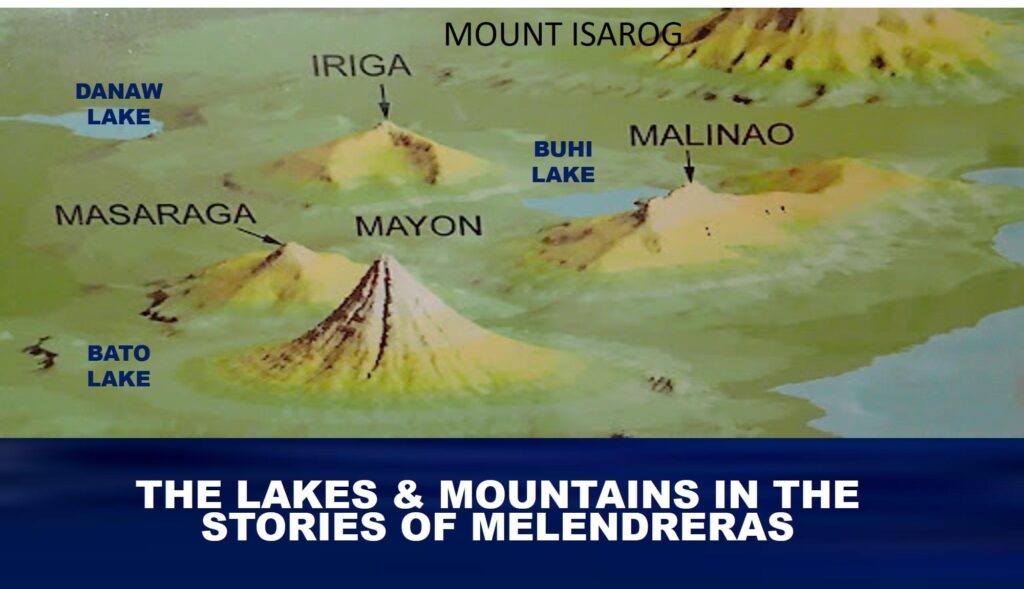By Abdon M. Balde Jr.
TO THE MAGICAL LAKE OF BUHI
Having familiarized you on the supernatural world of the ancient Bikolanos, I return to my personal travels at ground zero in search for Ibalong. My next agenda was to research for the lakes mentioned in the narrative.
The narrative told that in the time of Handiong, there occurred a great upheaval: “Hubo entonces un diluvio/ promovido per el Onos/ que el aspect de esta tierra/ por complete trastorno.” In translation: “Then came a deluge on the land/ instigated by Onos / so that the features of this earth/ were completely changed” This was caused by the simultaneous eruption of volcanoes:
“Reventaron los volcanes/ Hantic, Colasi, Isarog/ y al mismo tiempo senntiose; un espantoso temblor.” In translation: “The volcanoes Hantik, Kulasi and Isarog erupted/ and at the same time was felt/ a great earthquake”
This was followed by the erosion of mountains: “En Bato se hundio un gran monte/ y un sitio aparecio/ el lago, hoy alimenta/ con su pesca a Ibalon” Again, in translation: “In Bato a great mountain sank/ and in its place appeared/ a lake, which supplied/ with fish the whole of Ibalong.”
What intrigued me at first was that Melendreras wrote another verse narrative about the legend of a flower named Tacay—not in Lake Bato but in Lake Buhi! In fact the 5th stanza of the narrative already mentioned the “deep lake where the fair Tacay was drowned.” Professor Espinas also informed me that it was only in Lake Buhi where I could find the flower named Tacay.
And since I was already familiar with the way to Buhi, I and my wife Fe decided to visit Lake Buhi first. The town of Buhi was a fishing village that flourished into a large town. As we enter the vicinity of the town, we could already smell dried fish everywhere. We asked around the way to the lake, and someone gave us the direction to Barangay Cabatuan. As we approach the place I could see the rugged side of Mount Iriga which collapsed during the reported eruption. Huge boulders could be seen from half of the edge of the mountain and many of these rolled down on both sides of the way. My fears were allayed by the sight of moss on the boulders which attest that those huge stones have not moved for a long time. In Lake Buhi fishermen could still catch the sinarapan or tabios—the smallest commercially available fish in the world. A normal human thumb nail could hold as much as ten tabios. Fishermen catch them with a mosquito net. But the lake now is one of the biggest supplier of tilapia in the region. The tabios have became rare because the bigger tilapia eat them.
We came to a big resort, allegedly owned by a businessman named Cyrus Obsuna. It was a big resort, complete with a hotel, a swimming pool, cabanas, and a large display of motorcycles—mostly large vintage Harley Davidson. The resort featured a boat ride from a small pier where canoes were anchored. I hired a man to go out into the lake and look for the Tacay flower. He came back with a flower with many similarities to the lotus—but it was entirely white. Again, I looked at the other side of the 17 square kilometres lake and watched the rugged Mount Malinao—at the foot of which was Tiwi, where my wife Fe was born and grew up.
If the lair of Oryol was at the foot of Mount Iriga, then only the lake separate it from Mount Malinao. It was right there and then that I thought: Would it be possible that Handiong, coming from a cave under Mount Malinao be able to meet Oryol under this Buhi Lake? Who knows? I must explore that possibility. But wait, didn’t the narrative cited Lake Bato and not Lake Buhi? Lake Bato and Lake Buhi are over 25 kilometers apart! It was at that time that I also remember about the legend of the water hyacinth, the north wind and the god of the whirlwinds. My next destination then must be Lake Bato!

